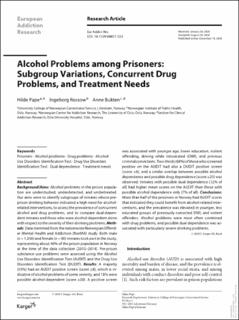| dc.description.abstract | Background/Aims: Alcohol problems in the prison population are understudied, underdetected, and undertreated. Our aims were to identify subgroups of inmates whose pre-prison drinking behavior indicated a high need for alcohol-related interventions, to assess the prevalence of concurrent alcohol and drug problems, and to compare dual-dependent inmates and those who were alcohol-dependent alone with respect to the severity of their drinking problems. Methods: Data stemmed from the nationwide Norwegian Offender Mental Health and Addiction (NorMA) study. Both male (n = 1,356) and female (n = 90) inmates took part in the study, representing about 40% of the prison population in Norway at the time of the data collection (2013–2014). Pre-prison substance use problems were assessed using the Alcohol Use Disorders Identification Test (AUDIT) and the Drug Use Disorders Identification Test (DUDIT). Results: A majority (55%) had an AUDIT positive screen (score ≥8), which is indicative of alcohol problems of some severity, and 18% were possible alcohol-dependent (score ≥20). A positive screen was associated with younger age, lower education, violent offending, driving while intoxicated (DWI), and previous criminal convictions. Two-thirds (68%) of those who screened positive on the AUDIT had also a DUDIT positive screen (score ≥6), and a similar overlap between possible alcohol dependence and possible drug dependence (score ≥25) was observed. Inmates with possible dual dependence (12% of all) had higher mean scores on the AUDIT than those with possible alcohol dependence only (7% of all). Conclusions: More than half of the prisoners in Norway had AUDIT scores that indicated they could benefit from alcohol-related interventions, and the prevalence was elevated in younger, less educated groups of previously convicted DWI, and violent offenders. Alcohol problems were most often combined with drug problems, and possible dual dependence was associated with particularly severe drinking problems. | |
